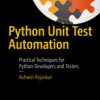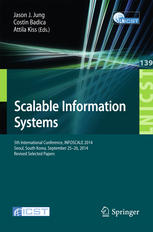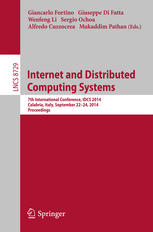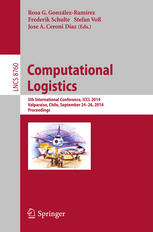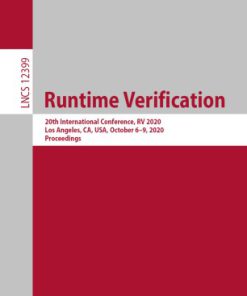Runtime Verification 5th International Conference RV 2014 Toronto ON Canada September 22 25 2014 Proceedings 1st Edition by Borzoo Bonakdarpour, Scott A Smolka ISBN 3319111639 9783319111643
$50.00 Original price was: $50.00.$25.00Current price is: $25.00.
Runtime Verification 5th International Conference RV 2014 Toronto ON Canada September 22 25 2014 Proceedings 1st Edition by Borzoo Bonakdarpour, Scott A Smolka – Ebook PDF Instant Download/Delivery: 3319111639, 9783319111643
Full download Runtime Verification 5th International Conference RV 2014 Toronto ON Canada September 22 25 2014 Proceedings 1st Edition after payment

Product details:
ISBN 10: 3319111639
ISBN 13: 9783319111643
Author: Borzoo Bonakdarpour, Scott A Smolka
This book constitutes the refereed proceedings of the 5th International Conference on Runtime Verification, RV 2014, held in Toronto, ON, Canada in September 2014. The 28 revised full papers presented together with 2 tool papers, and 8short papers were carefully reviewed and selected from 70 submissions. The scope of the conference was on following topics: monitoring and trace slicing, runtime verification of distributed and concurrent systems, runtime Verification of real-time and embedded systems, testing and bug finding, and inference and learning.
Runtime Verification 5th International Conference RV 2014 Toronto ON Canada September 22 25 2014 Proceedings 1st Table of contents:
1 Introduction
2 Format of the Competition
2.1 Declaration of Intent and Submission of Benchmarks and Specifications
2.2 Training Phase and Monitor Collection phase
2.3 Benchmark Evaluation Phase
3 Evaluation – Calculating Scores
3.1 Correctness Score
3.2 Overhead Score
3.3 Memory Utilization Score
3.4 Final Score
4 Concluding Remarks
References
Monitoring and Trace Slicing
Multiple Ways to Fail: Generalizing a Monitor’s Verdict for the Classification of Execution Traces
1 Introduction
2 Traces and Temporal Specifications
3 Natural Generalizations of κ
4 Conclusion and Future Work
References
Two Generalisations of Ro¸su and Chen’s Trace Slicing Algorithm A
1 Introduction
1.1 Fixed-Priority Scheduling
1.2 Overview of the Paper
2 Algorithm A Revisited
2.1 Partial Orders and Upper Semilattices
2.2 Partial Functions
2.3 Traces and Slices
2.4 The Algorithm
3 Combining Multiple Activity Streams into One Slice
3.1 Events and Event Patterns
3.2 Slicing Based on Patterns
3.3 Examples
4 Adding Constraints
4.1 Constraint Solving
4.2 Slicing with Constraints
4.3 Experiments
5 Conclusions
References
Scalable Offline Monitoring
1 Introduction
2 Preliminaries
3 Log Slicing
3.1 Slicing Foundations
3.2 Basic Slicers
3.3 Parallel Implementation
4 The Google Case Study
5 Related Work
6 Conclusion
References
Monitoring Systems with Extended Live Sequence Charts
1 Introduction
2 Extended Universal Live Sequence Charts
2.1 Universal Live Sequence Charts
2.2 Expressiveness of LSC Specifications
2.3 Extended LSCs
2.4 Concatenations of Universal LSCs
3 A Translation of eLSCs into LTL Formulae
3.1 Preliminaries
3.2 Translation of Universal Charts
4 An Algorithm for Checking eLSCs with Iteration
4.1 Decomposing Traces
4.2 Checking Sub-traces
5 Case Study: The RBC/RBC Handover Process
6 Conclusion and Discussion
References
Foundations of Boolean Stream Runtime Verification
1 Introduction
2 Stream Runtime Verification (SRV)
3 BSRV as Language Recognizers
4 Offline Monitoring for Well-Defined BSRV
5 Decision Problems
6 Conclusion
References
Portable Runtime Verification with Smartphones and Optical Codes
1 Introduction
2 Architecture
2.1 Instrumentation
2.2 Monitoring
3 Experimental Results
4 Conclusion and Future Work
References
Robust Consistency Checking for Modern Filesystems
1 Introduction
2 Robust Consistency Checking
2.1 Abstractions for Runtime Checking
2.2 Expressing Invariants
2.3 Checking Structure before Semantics
3 Experiences with Invariants
4 Conclusions
References
Runtime Verification of Distributed and Concurrent Systems
On the Number of Opinions Needed for Fault-Tolerant Run-Time Monitoring in Distributed Systems
1 Introduction
2 Distributed System Model
3 Distributed Languages and Wait-Free Monitoring
3.1 Distributed Languages
3.2 Decentralized Monitoring
3.3 Opinion and Alternation Numbers
4 Monitoring Leader Election
5 Main Result
6 Orientation-Detection Tasks, and Proof of Theorem 1
6.1 Tasks and Combinatorial Topology Terminology
6.2 Orientation-Detection Tasks
6.3 Equivalence Lemma
6.4 Sketch of the Proof of Theorem 1
7 Conclusions and Future Work
References
Supporting the Specification and Runtime Validation of Asynchronous Calling Patterns in Reactive Sys
1 Introduction
2 TinyOS and nesC
3 The Specification Approach
3.1 The Invariant as an Idiom
3.2 Refining Promises
4 nesC / TinyOS Tool-Chain Extensions
4.1 Annotations
4.2 Overhead Evaluation
4.3 Monitoring Promises at Runtime
4.4 Using PromiseTracker during Development
5 Related Work
6 Conclusion
References
Speculative Program Parallelization with Scalable and Decentralized Runtime Verification
1 Introduction
2 Motivating Example
3 Dynamic and Speculative Polyhedral Parallelization with Apollo
3.1 Compliance with the Polyhedral Model
3.2 Speculative Parallelization and Runtime Verification
4 Runtime Verification of Speculative Polyhedral Parallelization
4.1 Target Memory Address Verification
4.2 Scalars Initialization and Verification
4.3 Loop Bounds Verification
5 Related Work
6 Experiments
7 Conclusion
References
Organising LTL Monitors over Distributed Systems with a Global Clock
1 Introduction
2 Background
3 Orchestration
4 Migration
5 Choreography
5.1 Choreography at an Abstract Level
5.2 Formalizing Choreography
6 Evaluation and Discussion
6.1 Choreography and Migration
6.2 Choreography and Orchestration
7 Related Work
8 Conclusions and Future Work
References
Dynamic Verification for Hybrid Concurrent Programming Models
1 Introduction
2 Motivation
3 System Overview
3.1 Probabilistic Concurrency Testing
3.2 Our Method and Implementation
4 Conclusion and Ongoing Work
References
Abstraction and Mining of Tracesto Explain Concurrency Bugs
1 Introduction
2 Executions, Failures, and Bug Explanation Patterns
2.1 Programs and Failing Executions
2.2 Events, Transactions, and Traces
2.3 Bug Explanation Patterns
2.4 Mining Bug Explanation Patterns
3 Mining Abstract Execution Traces
3.1 Abstracting Execution Traces
3.2 Mining Patterns from Abstract Traces
3.3 Filtering Misleading Patterns
3.4 Deriving Macros from Traces
4 Experimental Evaluation
5 Related Work
6 Conclusion
References
Runtime Verification of Real-Time and Embedded Systems
Online Monitoring of Metric Temporal Logic
1 Introduction
2 Related Work
3 Background
3.1 Metric Temporal Logic
3.2 Truncated Semantics and Informative Prefixes
4 LTL[U, S] over Bounded Atoms
4.1 Normal Form
4.2 Extracting Unbounded Operators from Bounded Operators
5 Online Monitoring Procedure
5.1 Untimed LTL[U, S] Part
5.2 Bounded Metric Part
5.3 Correctness
6 Conclusion
References
On Real-Time Monitoring with Imprecise Timestamps
1 Introduction
2 Preliminaries
3 MTL Monitoring of Imprecisely Timestamped Traces
4 Discussion
References
ModelPlex: Verified Runtime Validation of Verified Cyber-Physical System Models
1 Introduction
2 Preliminaries: Differential Dynamic Logic
3 ModelPlex Approach for Verified Runtime Validation
3.1 Relation between States
3.2 ModelPlex Monitor Synthesis
3.3 Controller Monitor Synthesis
3.4 Monitoring in the Presence of Expected Uncertainty and Disturbance
3.5 Monitoring Compliance Guarantees for Unobservable Intermediate States
3.6 Decidability and Computability
4 Evaluation
5 Related Work
6 Conclusion
References
Runtime Observer Pairs and Bayesian Network Reasoners On-board FPGAs: Flight-Certifiable System Heal
1 Introduction
1.1 Related Work
1.2 Contributions
2 Preliminaries
2.1 Temporal-Logic Based Runtime Observer Pairs [15]2.2 Bayesian Networks for Health Models
2.3 Digital Design 101 and FPGAs
3 System Overview
3.1 Software
3.2 Hardware
4 FPGA Implementation of MTL/Mission-Time LTL
5 FPGA Implementation of Bayesian Networks
6 Case Study: Fluxgate Magnetometer Buffer Overflow
6.1 The Bayesian Health Model
7 Conclusion
References
On-Line Monitoring for Temporal Logic Robustness
1 Introduction
2 Problem Formulation
3 Robustness of Metric Temporal Logic Specifications
4 Robustness Monitoring of MTL<+∞ +pt
4.1 Finite Horizon and History of MTL<+∞ +pt
4.2 Robustness Computation Algorithm
5 Experimental Analysis and Case Studies
5.1 Runtime Overhead
5.2 Case Study
6 Conclusions and Future Work
References
ROSRV: Runtime Verification for Robots
1 Introduction
2 Robot Operating System (ROS)
2.1 ROS Safety and Security Issues
3 ROSRV
3.1 Monitoring Safety Properties
3.2 Enforcing Security Policies
4 Current Limitations and Future Work
5 Conclusion
References
Testing and Bug Finding
Symbolic Execution Debugger (SED)
1 Introduction
2 Symbolic Execution
3 Basic Usage of the Symbolic Execution Debugger
4 Usage Scenarios
5 Related and Future Work
References
Checking Data Structure Properties Orders of Magnitude Faster
1 Introduction
2 Our Approach
2.1 Memoizing Fields for Formal Contracts
2.2 Utilizing Static Verification
3 Evaluation
References
Dynamic Test Generation with Static Fields and Initializers
1 Introduction
2 Static Fields as Input
3 Initialization with Precise Semantics
3.1 Controlling Initialization
3.2 Dynamic Symbolic Execution
4 Initialization with Before-Field-Init Semantics
5 Experimental Evaluation
6 Conclusion
References
RV-Monitor: Efficient Parametric Runtime Verification with Simultaneous Properties
1 Introduction
2 Formal Specifications from the Java API Specification
2.1 Java API Specification
2.2 Separating Specification-Implying Text
2.3 Writing Formal Specifications
2.4 Classifying Formal Specifications
3 Scalable Runtime Verification
3.1 Global Weak Reference Table
3.2 Caches for the Global Weak Reference Table
3.3 Combining Indexing Trees
3.4 Fine-Grained Locking
4 Implementation and Evaluation
4.1 Implementation
4.2 Correctness of Formal Specifications
4.3 Runtime Overhead
4.4 Bug Finding
4.5 Ineffectual Approaches
5 Related Work
6 Conclusion
References
Inference and Learning
Improving Dynamic Inference with Variable Dependence Graph
1 Introduction
1.1 Motivating Example
2 Relating VDG to Invariants
3 Experiments
4 Conclusion and Future Work
References
The TTT Algorithm: A Redundancy-Free Approach to Active Automata Learning
1 Introduction
1.1 Practical Motivation
2 Preliminaries
2.1 Alphabets, Words, Languages
2.2 Deterministic Finite Automata
3 The TTT Algorithm
3.1 Active Automata Learning in the MAT Model
3.2 Running Example
3.3 Discrimination Trees
3.4 Key Steps
3.5 Complexity
4 Experimental Evaluation
4.1 Results
5 Related Work
6 Conclusion
6.1 Future Work
References
Lazy Symbolic Execution for Enhanced Learning
1 Introduction
2 Examples
3 Preliminaries
4 Algorithm
5 Implementation and Evaluation
6 Related Work and Concluding Discussion
7 Conclusion
References
Faster Statistical Model Checking by Means of Abstraction and Learning
1 Introduction
2 Background
2.1 Probabilistic Models
2.2 Probabilistic Linear Time Temporal Logic (PLTL)
2.3 Statistical Model Checking (SMC)
2.4 Probabilistic Learning
3 Learning Abstract Models
3.1 Main Steps
3.2 Correctness
4 Case Study: Herman’s Self Stabilizing Protocol
5 Related Work
6 Conclusion
People also search for Runtime Verification 5th International Conference RV 2014 Toronto ON Canada September 22 25 2014 Proceedings 1st:
runtime verification 5th international conference rv 2014
runtime verification inc
runtime verification
gulfstream gvii-2
i rv 2
Tags:
Borzoo Bonakdarpour,Scott A Smolka,Runtime Verification,International Conference,Toronto,Canada
You may also like…
Computers - Networking
Computers - Computer Science
Computers - Computer Science



